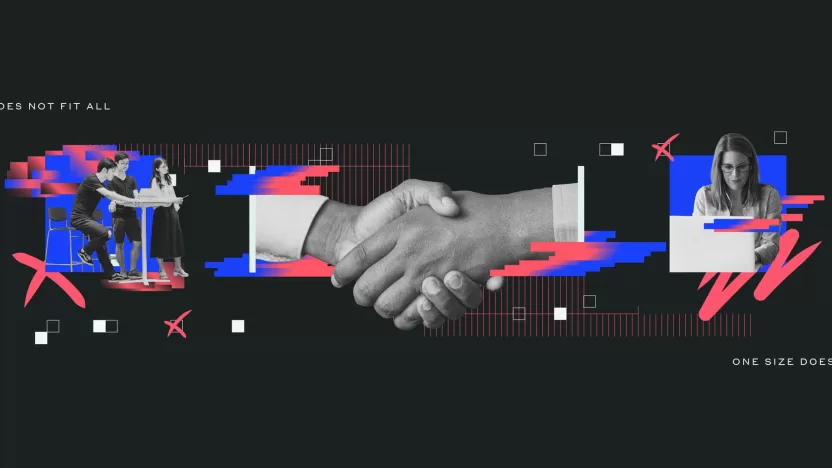Docking on the invisible Cracker Island
The top-down view of a structure does not capture reality. A hallucination that Calvino and the Gorillaz had already explained
by Silvia Catanuso

Illustrations by Francesca Ragazzi
Let’s start from the beginning. What do we mean when we refer to interfaces? At its core, an interface is where different components interact. In the computer world, interfaces have advanced from simple command lines to sophisticated graphical interfaces designed to make technology more accessible. Even in purely digital ecosystems — and we notice this as consumers — interfaces sometimes obscure functionality rather than enhance the user experience, leading to a paradox where attempts at simplification generate further complexity.
In an organizational context, interfaces arise as connections among departments, teams, and individuals. They are meant to facilitate communication, coordination, and control. Paradoxically, as organizations grow, the proliferation of these interfaces often leads to bureaucratic overload, stifling the innovation and agility they are designed to foster.
As an organizational culture enthusiast, I have quite often come across all kinds of metaphors used to describe the organization, teams, leadership, relationships, and so on. When I found myself putting my thoughts on organizational interfaces on paper, I (predictably) fell into a swirling stream of consciousness with no apparent head or tail. In my wandering between intuition, semi–certainty, and reality checks, I thought that there must be a concept that could perfectly fit my vision of interfaces.
This concept led me to link Calvino’s thoughts in Invisible Cities (1972) with those of Damon Albarn and the virtual band Gorillaz in the song Cracker Island (2022). What made them seem so similar to me despite the 50–year gap between their publications? And what links Invisible Cities, Cracker Island, and organizational interfaces? It is quickly said: illusion. Cracker Island is an imaginary island that symbolizes a place where people are trapped in a cycle of homogenizing, designed-in-a-vacuum conventions, alienated from reality, and lacking authentic connection with others.
In the magical labyrinth of Italo Calvino’s Invisible Cities, the traveler Marco Polo tells stories of cities so diverse and fantastic that they seem to defy the very notion of geography. Each city, with its intricate architecture and unique customs, embodies the paradoxes and possibilities of the human imagination. Similarly, in an attempt to manage complexity, modern organizations (but perhaps this has always been the case, without bringing up the concept of modernity) often create layers upon layers of interfaces, points of contact intended to simplify (and separate) operations and clarify roles.
However, like Calvino’s imaginary cities and the manufactured reality of Gorillaz’s island, these interfaces often create deceptions that obscure the complex dynamics of organizational life. The temptation to add more interfaces stems from the need (or, perhaps more accurately, the desire) for control. Delineating multiple touchpoints provides the illusion that one can better manage the flow of information, monitor performance, and ensure alignment with strategic goals.

However, this approach often ends up centralizing power at the top of the organization, limiting the autonomy and decision–making capabilities of lower levels. This centralization creates an illusion of control. Although it may appear that information flows smoothly through well–defined channels, the reality is often a tangled web of bottlenecks and misunderstandings. The true dynamics of the organization — informal networks, organic interactions, and spontaneous collaboration — are obscured by rigid structures that fail to capture the fluidity of human interactions. More interfaces not only create inefficiencies, as each additional layer requires oversight, maintenance, and troubleshooting, but they also delay decision–making and natural change. Fluidity, adaptability, and speed are critical in a rapidly changing business environment.
Organizations burdened with too many interfaces struggle to change quickly because rigid structures hinder rapid response to new opportunities or threats. Despite being considered necessary, official organizational charts often fail to accurately reflect the actual workings of a business. There are dense networks of informal relationships, often overlooked, that enable the company to exist, survive, and fulfill its much–vaunted mission by leveraging the contributions of its people. By identifying, monitoring, and leveraging these latent flows — while moving away from conventional command & control structures — organizations can foster vibrant ecosystems and empower their people according to their individual strengths.
So, can organizations truly navigate growing complexity without falling into the illusory reliance on interfaces? Consider the lesson of Calvino’s cities. Each city in Invisible Cities is more than a place: it reflects human experiences, dreams, and fears. Similarly, an organization’s interfaces are more than just structures: they reflect the company’s culture, values, and vision. Simplifying processes and enhancing meaningful interfaces does not mean eliminating all the structures but rather focusing on what really matters: empowering people at all levels to make decisions and take action.
Aaron Dignan was a pioneer in linking organizations with the concept of operating systems. And just like operating systems, organizations need periodic updates, patches, and reconfigurations to remain secure and efficient. This involves not only adding or deleting interfaces but also rethinking and refining existing ones. It means focusing on the quality of interactions rather than the quantity. Just as the cities in Calvino’s tales are constantly reimagined, organizations must constantly refine their structures to remain vital and responsive. The key is not the number of interfaces but the quality and flexibility of the connections they create.


